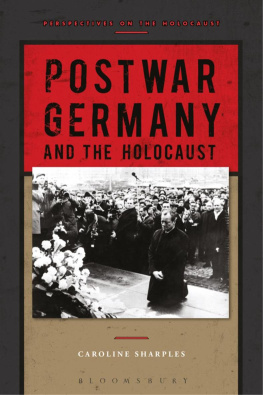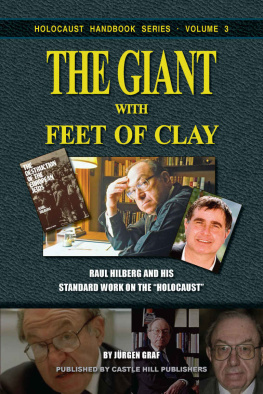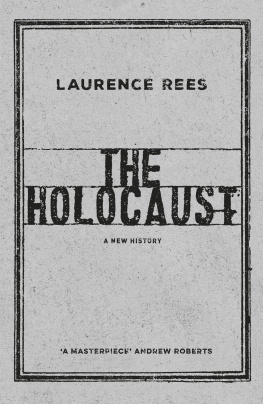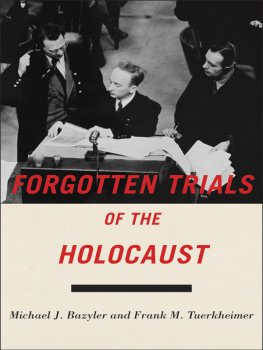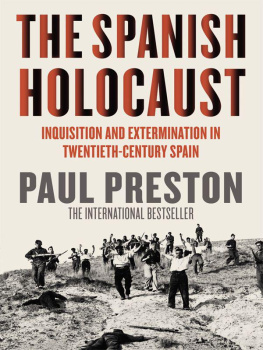THE ANATOMY OF THE HOLOCAUST
Vermont Studies on Nazi Germany and the Holocaust
Editorial Committee:
Jonathan D. Huener, University of Vermont
Francis R. Nicosia, University of Vermont
Susanna Schrafstetter, University of Vermont
Alan E. Steinweis, University of Vermont
The University of Vermont has been an important venue for research on the Holocaust since Raul Hilberg began his work there in 1956. These volumes reflect the scholarly activity of UVMs Miller Center for Holocaust Studies. They combine original research with interpretive synthesis and address research questions, interdisciplinary investigations, and international interests.
Medicine and Medical Ethics in Nazi Germany: Origins, Practices, Legacies
Edited by Francis R. Nicosia and Jonathan Huener
Business and Industry in Nazi Germany
Edited by Francis R. Nicosia and Jonathan Huener
The Arts in Nazi Germany: Continuity, Conformity, Change
Edited by Jonathan Huener and Francis R. Nicosia
Jewish Life in Nazi Germany: Dilemmas and Responses
Edited by Francis R. Nicosia and David Scrase
The Law in Nazi Germany: Ideology, Opportunism, and the Perversion of Justice
Edited by Alan E. Steinweis and Robert D. Rachlin
The Germans and the Holocaust: Popular Responses to the Persecution and Murder of the Jews
Edited by Susanna Schraftetter and Alan E. Steinweis
Nazism, the Holocaust, and the Middle East: Arab and Turkish Responses
Edited by Francis R. Nicosia and Boa A. Ergene
The Anatomy of the Holocaust: Selected Works from a Life of Scholarship
Raul Hilberg; edited by Walter H. Pehle and Ren Schlott
Raul Hilberg
THE ANATOMY OF THE HOLOCAUST

Selected Works from a Life of Scholarship
Edited by
Walter H. Pehle
and
Ren Schlott

Published in 2020 by
Berghahn Books
www.berghahnbooks.com
English-language edition 2020 Berghahn Books
Originally published in German as
Anatomie des Holocaust: Essays und Erinnerungen
S. Fischer Verlag GmbH, Frankfurt am Main, 2016
All rights reserved. Except for the quotation of short passages for the purposes of criticism and review, no part of this book may be reproduced in any form or by any means, electronic or mechanical, including photocopying, recording, or any information storage and retrieval system now known or to be invented, without written permission of the publisher.
Owing to limitations of space, reprint credits can be found on pages viiviii.
Library of Congress Cataloging-in-Publication Data
Names: Hilberg, Raul, 19262007, author. | Pehle, Walter H., 1941 editor. | Schlott, Ren, 1977 editor.
Title: The Anatomy of the Holocaust: Selected Works from a Life of Scholarship / Raul Hilberg, edited by Walter H. Pehle and Ren Schlott.
Other titles: Anatomie des Holocaust. English
Description: First edition. | New York; Oxford: Berghahn Books, 2020. | Series: Vermont studies on Nazi Germany and the Holocaust; vol 8 | Originally published in German as Anatomie des Holocaust: Essays und Erinnerungen, S. Fischer Verlag GmbH, Frankfurt am Main, 2016title page verso. | Includes bibliographical references and index.
Identifiers: LCCN 2019033792 (print) | LCCN 2019033793 (ebook) | ISBN 9781789203554 (hardback) | ISBN 9781789204896 (paperback) | ISBN 9781789203561 (ebook)
Subjects: LCSH: Holocaust, Jewish (19391945) | Holocaust, Jewish (19391945)Historiography. | Hilberg, Raul, 19262007.
Classification: LCC D804.3 .H5413 2020 (print) | LCC D804.3 (ebook) | DDC 940.53/18dc23
LC record available at https://lccn.loc.gov/2019033792
LC ebook record available at https://lccn.loc.gov/2019033793
British Library Cataloguing in Publication Data
A catalogue record for this book is available from the British Library
ISBN 978-1-78920-355-4 hardback
ISBN 978-1-78920-489-6 paperback
ISBN 978-1-78920-356-1 ebook
CONTENTS
Walter H. Pehle and Ren Schlott
ACKNOWLEDGMENTS
The editors and publisher wish to thank the following for granting reprint permissions:
3. The Bureaucracy of Annihilation from Unanswered Questions, edited by Franois Furet, translated by Benjamin Ivry, translation copyright 1989 Penguin Random House LLC. Used by permission of Schocken Books, an imprint of the Knopf Doubleday Publishing Group, a division of Penguin Random House LLC. All rights reserved. The same material is used with the additional permission of ditions du Seuil, publisher of the French edition of the anthology LAllemagne nazis et le genocide juif. Colloque de lEcole des Hautes Etudes en Sciences Sociales, ditions du Seuil, 1985.
6. Bitburg as Symbol, from Bitburg in Moral and Political Perspectives, ed. Geoffrey Hartman 1986. Reprinted with permission of Indiana University Press.
7. The Ghetto as a Form of Government, from The Annals of the American Academy of Political Social Science 450, no. 1 1980. Previously published by SAGE Publications.
8. The Judenrat: Conscious or Unconscious Tool, from Pattern of Jewish Leadership in Nazi Europe 19331945 1979. Reprinted with permission of Yad Vashem Publications.
9. I Was Not There, from Writing and the Holocaust, ed. Berel Lang 1988. Reprinted with permission from Berel Lang.
10. The Holocaust Mission: 29 July to 12 August 1979, from St. Johns Review 34, no. 1 198283.
12. Working on the Holocaust, from The Psychohistory Review 14, no. 3 1986. Originally printed and edited by Sangamon State University; reprinted with permission of University of Illinois Springfield.
13. The Development of Holocaust Research: A Personal Overview, from Holocaust Historiography in Context, ed. David Bankier and Dan Michman 2008. Reprinted with permission of Yad Vashem Publications.
INTRODUCTION
WALTER H. PEHLE AND REN SCHLOTT

I am not a man who gives in.
Raul Hilberg in Weimar, 1995
ANYONE WHO INVESTIGATES THE PERSECUTION and murder of the Jews during National Socialism and World War II knows the name of Raul Hilberg. His work, The Destruction of the European Jews, remains indispensable even today. There are many other texts, however, in which Raul Hilberg offers important contributions to various debates in this field. A few of these still relatively inaccessible texts are now published together in one collection in their original language.
This volume of Hilbergs texts also invites interested readers and Holocaust researchers to trace the development of his scientific work over more than five decades. The thirteen texts presented here were published between 1965, just a few years after the appearance of The Destruction of the European Jews, and 2007, the year Hilberg died. In them, Raul Hilberg not only reflects on the results of his research and the controversies it generated, but also describes his perception of the ways the Holocaust is remembered. And, finally, the texts recount Hilbergs own memories of archival visits gathering material for his research work. They convey a sense of how the true extent of what was then known as the Final Solution was only gradually understood through the difficult process of digesting tens of thousands of administrative and court files after World War II. They show how the Holocaust became the subject of academic study and how this research developed into its current, highly professionalized form.
Next page

